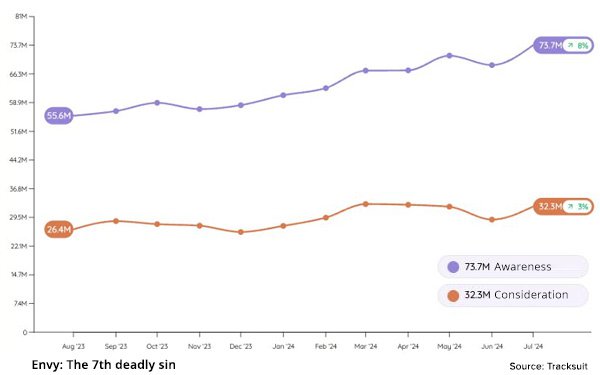
Consumer attention is difficult to capture, but
emotional storytelling -- rather than rational approaches to advertising -- can dramatically drive brand growth and success.
The Emotion Effect, a new white paper from brand-tracking
organization Tracksuit, found ads that evoke positive emotions are 42% more likely to drive long-term brand growth and 27% more likely to go viral and generate word-of-mouth.
All these
positives lead to stronger customer loyalty and increased lifetime value.
Emotional ads running on YouTube are 40% more likely to make consumers less sensitive to price, meaning they are
willing to pay more for a brand, according to Google and Ipsos. Google Global Head of Research Ariane Pol provided insight from YouTube to support the white paper’s findings.
The report
outlines seven “deadly sins” of emotionless advertising and has the goal of presenting evidence that emotional storytelling outperforms rational approaches across all platforms.
advertisement
advertisement
Understanding these principles can help marketers balance short-term gains and long-term brand health, the report notes.
The 7 "sins" include:
- Greed
- Wrath
- Sloth
- Lust
- Pride
- Gluttony
- Envy
Each of these sins has an explanation attached that provide insights into how to approach decisions,
especially during the holidays. I won't provide details on all of them,
For example, "greed" manifests when marketers use their resources to buy target audiences in brand awareness.
It’s possible to buy awareness through a huge media spend but the research shows that unless the message is perfect, that type of spending is not effective. A more telling metric, according
to the report, is the measurement of fame.
"Wrath" is characterized by forcefulness, and can be seen when marketers use aggressive promotional techniques and rational messaging to shout out to
their audience without first building positive feelings toward the brand.
Ipsos showed there are five key positive emotions that are statistically significant predictors of an ad’s
effectiveness -- including surprise, empathy, excitement, happiness and curiosity.
When triggered, those feelings make people much more likely to consider purchasing with the brand. Emotional
storytelling is much more likely to trigger the purchase.
Research by Google and Ipsos found that consumers are more likely to value brands and consider them when they are differentiated,
relatable, and provide a new perspective.
One hundred YouTube ads with a panel of 15,000 respondents found the ads that elicited a positive emotional reaction were significantly more effective
at driving those values.
Moving to "sloth" -- a word that most associate with laziness -- this indicates a focus on rational messaging to achieve short-term sales targets, prioritizing volume
over profitability, and neglecting to foster the brand’s pricing power, is the lazy and easy path to take.
Sloth should be avoided to see more potential, per the study. While it is
a rare objective for marketing, it has become more important as financial markets have turned against growth companies that are unprofitable.
Google and Ipsos found that emotional YouTube ads
were much more likely to reduce a brand’s price sensitivity.
According to a pre/post survey of Long Term Brand Build Ads on YouTube led by Ipsos, ads that made “respondents feel
highly pleasant emotions" led to a more than 40% increase in consumers saying “(brand)…is worth paying more for.”
For example, Tracksuit's data shows 39% of American
consumers aware of premium skincare brand La Roche-Posay believe the brand is worth paying a higher price. This means that regardless of economic conditions or sales events, La Roche-Posay maintains
its higher prices.
"Lust" -- or instant gratification without self-control -- is when a marketer focuses on capturing existing demand and ignores future demand.
Rational ads are
easy-to-target advertisers that know the purchase process and can address the barriers, but Ehrenberg-Bass Institute for Marketing estimate this group to only be about 5% of the total group of
category buyers. The other 95% -- who are not in the market -- could come later, and may need a different style of communication.
Emotional advertising is very effective at creating feelings
such as likeability, affinity and empathy.
Whether it’s on TV, social media, a billboard or YouTube, emotional advertising creates future demand -- seeding positive feelings that can
prompt the consumer to come into the market in the next week, month, year or, yes, even decade.
"Envy" -- the seventh deadly sin -- is when a business blatantly copies their competitors or
follows what the category is doing. In order to stand out, businesses need to behave independently or even go against category norms by showing up in a way that provokes strong emotions.
According to Tracksuit’s data, people consider, on average, between two and three brands in a category. Getting into this already exclusive consideration set means being a business that is
easily recalled and remembered, rather than blending into the scenery.
“If you're trying to build your brand long term and people might not be in the market for it right now, it's about
taking them on a journey and sharing why you're different,” Pol wrote.
The canned water brand Liquid Death does this well, per the report. Rather than using minimalist, soft branding
with imagery of nature and water that is pure, pristine and natural, the brand goes in the complete opposite direction -- using the tagline “murder your thirst.”
Its 2024 Super
Bowl ad featured a bunch of kids at a birthday party chugging back on Liquid Death and going wild, with the tagline “Don’t be scared. It’s just water.”
Tracksuit’s data showed Liquid Death’s awareness in the U.S. since grew by 8% or about 18.1 million people, while consideration grew by 3% or about 5.9 million people.